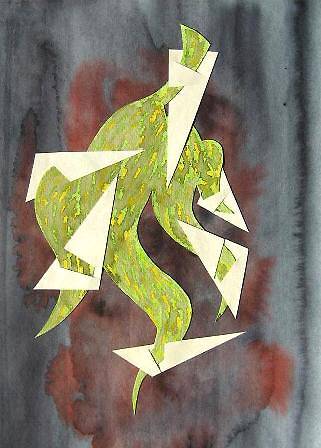Celebrating five years of Mariano Akerman's educational activities in Pakistan
Ilona Yusuf, "Enhancing Perception: The Gestalt Lectures and Collage Competition," Blue Chip Magazine, Issue 87, Volume 8, Islamabad, January-February 2012, pp. 16-19, ill.
Ilona Yusuf, writing from Islamabad:
Having organised and delivered lecture series on art in Karachi, Lahore and Islamabad over the last five years, Mariano Akerman proposed creating a programme which was not restricted to a select segment of society. Considering the role of the teacher as a mentor, key in firing the student’s imagination with ideas, Akerman, architect, artist and art historian, designed a lecture series for local educational institutions which would culminate in an open art competition.
Working with students from a wide range of disciplines, Akerman attempted to offer something that would influence not only the way they perceived art, but everything around them, initiating the germination of ideas and concepts and enabling them to combine and relate them. To this end he chose the Gestalt Movement. Gestalt (literal meaning ‘form’), or Theory of Visual Organisation, originated in the early 1920s with the work of three German psychologists and influenced modern educational theory as well as all branches of the arts, particularly the designers and artists of the Bauhaus School. Internationally renowned, this German school of design included Walter Gropius, Paul Klee, and Wassily Kandinsky among its teachers. Forced to close in 1933, many of its faculty members migrated to other countries. Their theories and achievements, emphasizing the beauty of simplicity and functionality, eventually dominated twentieth century aesthetics and design all over the world.
Akerman’s strength lies in his ability to transmit ideas through the use of what he calls visual communication. His lectures combine slide shows in which he strategically juxtaposes images against one another with the intention of illustrating the lecture, always delivered extempore, as well as triggering the audience’s responses. His training as an architect permeates his professional life as an artist and historian, enabling him to construct an integrated whole from many parts: in short, the definition of gestalt. The illustrations he uses are culled from diverse fields including art, architecture, graphic design, functional and decorative objects, and are often placed against older examples of similar objects from preceding time periods. Each slide is explained at length, with details of background and context: for instance, Insula Dulcamara, painted by Paul Klee after his exile to Switzerland, is analysed with reference to composition, colour and interpretation of shapes and historical context.
Gestalt, Theory and Design in the Age of New Objectivity was aimed at students from private as well as government institutions, including Islamabad College for Girls, the Postgraduate College for Women Rawalpindi, COMSATS University, Alliance Française d'Islamabad, Lahore Grammar School, the International School of Islamabad and the National University of Modern Languages. Although the project was partially funded by the Swiss and German embassies, the money donated covered only the cost of the lectures. Akerman himself raised funds through the sale of video presentations on gestalt, the proceeds of which went towards prizes for the winning art entries.
Since the art competition focused on the integration of parts to form a whole, and many of the participants were not art students, collage seemed the most natural genre to work with. Superficially, collage (from the French ‘coller,’ to glue) is a montage of different elements, not necessarily related, glued together or layered one over the other. But collage practised as a formal art, most significantly by twentieth century artists, expresses the idea of creating a new reality from given parts, which combine to form a whole, and is therefore closely related to the gestalt principle. Akerman is a collagist himself, creating works which explore visual, architectural elements as well as mood through form and colour, super-imposing sharp-edged, structured cut-outs over swirling water-colour washes, and combining stark contrasts. "It’s not the glue that makes the collage; rather, design and patterns are united with intuition," he states. Since it enables the artist to use his material to create something entirely different from what it was intended for, or to create a form which, viewed closely, appears different from one’s original perception, it is a flexible medium. This latter quality is exemplified by the optical illusion provided in Edgar Rubin’s drawing, one of the most famous examples of figure-ground organization. Here, if the viewer focuses on the white area, a vase appears, whereas focusing on the black areas reveals two faces in profile.
Judging by the overwhelming number of entries that flooded in – over four hundred – the ideas transmitted during the lectures had been thoroughly absorbed. The prize winning entries were outstanding. Although the students had rudimentary backing materials for their collages, their grasp of the basic concept was consistently visible in what they produced. The use of diverse materials, from the more conventional paper collage to scraps of cloth, metal chain, and stitching add to the richness and texture of the works, particularly those which demonstrate complex, multiple themes.
The winning collage, by Haider Abbas from Comsats University, uses the figure-ground relationship to show what at first glance appears to be a hand thrown dramatically into the air; but on looking closely one sees that the hand and the connecting arm are thrust between the legs of a half torso. Saweera Gul’s autumnal tree is another play on the viewer’s vision, mellower than the former, revealing a face composed of falling leaves and twigs beside the tree. Some of the entries show great maturity: Janita Fatima’s layered and clustered images which make up a face and a spiral, bombard the viewer with issues and question materialism; while Ikram Haider’s complex Everything or Nothing at All questions, among other things, standards of beauty, of skin colour, and of choice, using cut-outs from magazines and painting reproductions. Certain areas are delineated with the use of mirror frames held up by masculine arms. Anum Hamid’s three half-zippered, blanket stitched cloth pockets in magenta, blue and green are a play on colour, curiosity and the V sign; and Saadia Arhsad’s Mystic Maze uses traditional paper collage, combining images from cave paintings, photographs of terraced fields and a layered and shaded sky to make her mystic maze, which a shrouded figure contemplates.
Reviewing the project, Akerman considers that the best entries came from the Post Graduate College for Women Rawalpindi, Comsats University and Islamabad College for Girls. None of these can be considered educational institutions which provide a sophisticated education in the arts. Given a little help, the students’ natural curiosity led them to produce artworks revealing their understanding of theory and process received during the lectures. He compares the educational system to his experience in the Philippines, where he conducted a series of lectures and an art project on the botanist Carl Linnaeus. He feels that perhaps because of the difficulties that Pakistan is going through: physical and emotional insecurity, often a lack of basic amenities necessary to a stress free study environment, and a deficiency of intellectual material, young people are more profound than elsewhere and all the more inspired when shown a way to be original. Akerman also commends the teachers, some of whom were being exposed to unconventional teaching methods, for responding by accepting and using what they learned, and acknowledged them by giving them prizes during the award ceremony for the collage competition winners, organised at the German Embassy in December 2011.
Mariano Akerman’s lecture series, funded by and conducted at embassies, the Alliance Française and other educational institutions, have been a personal effort at bridging the gap between cultures. As the creator of each programme, he has approached embassies and institutions to initiate them, and has been instrumental in organising, designing, lecturing, as well as taking on the time consuming task of designing the brochures meant to introduce each set of lectures. Painstakingly researched and enriched with a library of visual images, the lecture series have so far included Discovering Belgian Art in 2008, Raisons d’Être, Art, Liberty and Modernity in 2009; Shape and Meaning, The German Contribution to the Visual Arts in 2010; and Gestalt, Theory and Design in the Age of New Objectivity in 2011. This last has seen an additional role of jury for the art competition.
_____
Ilona Yusuf spent her early childhood in England, where she was born. Later her family moved to Lahore, Pakistan, where she was educated. She is a published poet, and an editor for the Alhamra Literary review, a collection of writing by Pakistani and South Asian writers in English. “Picture This…” is her first book of poems. She also designs lamps and furniture, both of which she likes to call 'conversation pieces' as they often incorporate the use of her photographs. Currently she is working on using her photographs to make prints, after learning solar printmaking techniques. She divides her time between Islamabad, Pakistan, and Scottsdale, Arizona.
Blue Chip Magazine. Launched in 2004, Blue Chip has emerged as Pakistan’s premiere business magazine. Featuring the latest economic data as well as regular telecommunications, energy, capital markets and industry updates, Blue Chip has become an indispensable decision making tool within all levels of the private and public sectors. The magazine currently has a circulation of 6,000 copies a month primarily to Pakistan’s private sector including all levels of the financial sector from junior executives to senior management, all levels of industry including the telecommunications, energy, textiles and IT sectors. Blue Chip is also widely circulated in Pakistani government departments including the Ministry of Finance, the Board of Investment, the Securities & Exchange Commission, the Competition Commission, the State Bank of Pakistan, the Ministry of Health and the Planning Commission. It is circulated among all the embassies in bulk, particularly the Saudi, UAE, Chinese, US, UK and Argentine embassies which are then sent on to the various ministries abroad. Blue Chip is currently available on all PIA, Etihad and Cathay Pacific international business class flights originating from Pakistan.
Gestalt Program Resources
The Gestalt Program ; Programa Educativo Gestalt
Islamabad, German Embassy in Islamabad, Integrated Whole, Experimentation and Identity, Gestalt: Theory and Design in the New Objectivity Age, 25.10.2011
Islamabad, Deutsche Auslandsvertretungen in Pakistan, Integriertes Ganzes, Experimentieren und Identität, Gestalt: Theorie und Gestaltung im Zeitalter der neuen Sachlichkeit, 28.10.2011
Sara Mahmood, Mariano Akerman: Bridging Cultures, 28.9.2011
Ishrat Hyatt, Gestalt Programme Launching Event, International The News, 22 October 2011, City News, p. 19 (S).
"The Ambassador of Switzerland ... held Reception Lecture of the Gestalt Educational Program held by Architect Mariano Akerman," Diplomatic Focus, Pakistan, Vol. II, Issue 8-9, October-November 2011, p. 70, photographs by Shabbir Hussain.
SwissPak Association
Almas Haider Naqvi, "Other is the Same Side of the Picture," Dataline Islamabad, 22 October 2011, p. 4
Maqbool Malik, "Tradition meets Modernisation," The Nation, Pakistan, 24 October 2011
Gauhar Zahid Malik, Embassies of Switzerland and Germany present 'Gestalt': Theory and Design in the Age of New Objectivity, Fifteen Educational Lectures by Mariano Akerman, Architect and Art Historian, Pakistan Observer, Pakistan, 3.11.11, p. 9.
Mariano Akerman, A Visual History of Gestalt Theory, 8.11.11
_____. Gestalt Program Pics and Musings, 30.10.11
Ilona Yusuf, "Enhancing Perception: The Gestalt Lectures and Collage Competition," Blue Chip Magazine, Issue 87, Volume 8, Islamabad, January-February 2012, pp. 16-19, ill.
Sara Mahmood, Mariano Akerman: Bridging Cultures, Blue Chip Magazine, Issue 87, Volume 8, Islamabad, January-February 2012, pp. 20-24, ill.
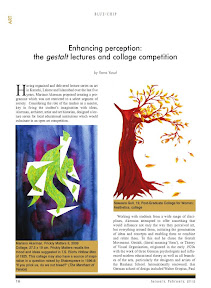


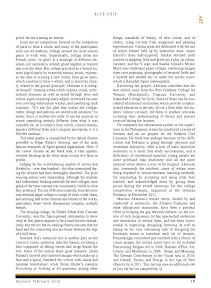
Comments received
1. Mi querido amigo este resumen de tu actuación concentra muy bien tu hacer y el valor que representa. Que tengas siempre la misma energía y capacidad de seguir por la misma exitosa senda [que hoy transitas] es lo que te deseo. Un beso fraternal. Gina desde el Centro
2. Herr Akerman, you should receive the first prize. The essay is well written and it has all what a good one needs to have. It is very interesting and covers your 5 years of stay in Pakistan, showing the fruits are ripe and giving the message you have worked on for so long. You get from me a medal. Deborah Cohen
3. Mariano: Leí el maravilloso artículo sobre tus cinco años en Pakistán. Siento asombro y orgullo por tu magnífica inserción en un mundo culturalmente diverso. Si "por los frutos los conoceréis", [entonces] ya puedo sentirme cumplida en esta vida. Tu capacidad intelectual, ética y de profunda llegada humana para con los asistentes a tus seminarios, te abren las puertas de cualquier lugar al que vayas. Importantes los antecedentes y el curriculum. Pero es el esfuerzo, el estudio profundo y permanente, la dedicación y la entrega con la que encaras todos tus trabajos los que construyen esos antecedentes. Eso se llama responsabilidad y amor por la tarea que realizás. Por eso, no dudo que continuarán los logros que cada vez serán aún más brillantes. NCL
Ilona Yusuf, "Enhancing Perception: The Gestalt Lectures and Collage Competition," Blue Chip Magazine, Issue 87, Volume 8, Islamabad, January-February 2012, pp. 16-19, ill.
 |
| Mariano Akerman, Eye, digital image, 2011 |
Ilona Yusuf, writing from Islamabad:
Having organised and delivered lecture series on art in Karachi, Lahore and Islamabad over the last five years, Mariano Akerman proposed creating a programme which was not restricted to a select segment of society. Considering the role of the teacher as a mentor, key in firing the student’s imagination with ideas, Akerman, architect, artist and art historian, designed a lecture series for local educational institutions which would culminate in an open art competition.
Working with students from a wide range of disciplines, Akerman attempted to offer something that would influence not only the way they perceived art, but everything around them, initiating the germination of ideas and concepts and enabling them to combine and relate them. To this end he chose the Gestalt Movement. Gestalt (literal meaning ‘form’), or Theory of Visual Organisation, originated in the early 1920s with the work of three German psychologists and influenced modern educational theory as well as all branches of the arts, particularly the designers and artists of the Bauhaus School. Internationally renowned, this German school of design included Walter Gropius, Paul Klee, and Wassily Kandinsky among its teachers. Forced to close in 1933, many of its faculty members migrated to other countries. Their theories and achievements, emphasizing the beauty of simplicity and functionality, eventually dominated twentieth century aesthetics and design all over the world.
 |
| Gestalt Principles. 12 Examples. A composition by Mariano Akerman The whole is different from the sum of its parts Theory of Perceptual Organization |
Akerman’s strength lies in his ability to transmit ideas through the use of what he calls visual communication. His lectures combine slide shows in which he strategically juxtaposes images against one another with the intention of illustrating the lecture, always delivered extempore, as well as triggering the audience’s responses. His training as an architect permeates his professional life as an artist and historian, enabling him to construct an integrated whole from many parts: in short, the definition of gestalt. The illustrations he uses are culled from diverse fields including art, architecture, graphic design, functional and decorative objects, and are often placed against older examples of similar objects from preceding time periods. Each slide is explained at length, with details of background and context: for instance, Insula Dulcamara, painted by Paul Klee after his exile to Switzerland, is analysed with reference to composition, colour and interpretation of shapes and historical context.
 |
| Studied in detail: Paul Klee's Insula dulcamara, 1938 |
Gestalt, Theory and Design in the Age of New Objectivity was aimed at students from private as well as government institutions, including Islamabad College for Girls, the Postgraduate College for Women Rawalpindi, COMSATS University, Alliance Française d'Islamabad, Lahore Grammar School, the International School of Islamabad and the National University of Modern Languages. Although the project was partially funded by the Swiss and German embassies, the money donated covered only the cost of the lectures. Akerman himself raised funds through the sale of video presentations on gestalt, the proceeds of which went towards prizes for the winning art entries.
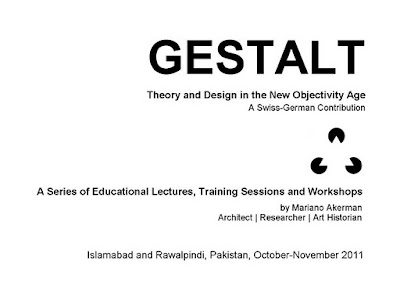 |
| Gestalt: Theory and Design in the Age of New Objectivity. A Series of Educational Lectures, October-November 2011 |
Since the art competition focused on the integration of parts to form a whole, and many of the participants were not art students, collage seemed the most natural genre to work with. Superficially, collage (from the French ‘coller,’ to glue) is a montage of different elements, not necessarily related, glued together or layered one over the other. But collage practised as a formal art, most significantly by twentieth century artists, expresses the idea of creating a new reality from given parts, which combine to form a whole, and is therefore closely related to the gestalt principle. Akerman is a collagist himself, creating works which explore visual, architectural elements as well as mood through form and colour, super-imposing sharp-edged, structured cut-outs over swirling water-colour washes, and combining stark contrasts. "It’s not the glue that makes the collage; rather, design and patterns are united with intuition," he states. Since it enables the artist to use his material to create something entirely different from what it was intended for, or to create a form which, viewed closely, appears different from one’s original perception, it is a flexible medium. This latter quality is exemplified by the optical illusion provided in Edgar Rubin’s drawing, one of the most famous examples of figure-ground organization. Here, if the viewer focuses on the white area, a vase appears, whereas focusing on the black areas reveals two faces in profile.
 |
| Rubin's extraordinary image |
Judging by the overwhelming number of entries that flooded in – over four hundred – the ideas transmitted during the lectures had been thoroughly absorbed. The prize winning entries were outstanding. Although the students had rudimentary backing materials for their collages, their grasp of the basic concept was consistently visible in what they produced. The use of diverse materials, from the more conventional paper collage to scraps of cloth, metal chain, and stitching add to the richness and texture of the works, particularly those which demonstrate complex, multiple themes.
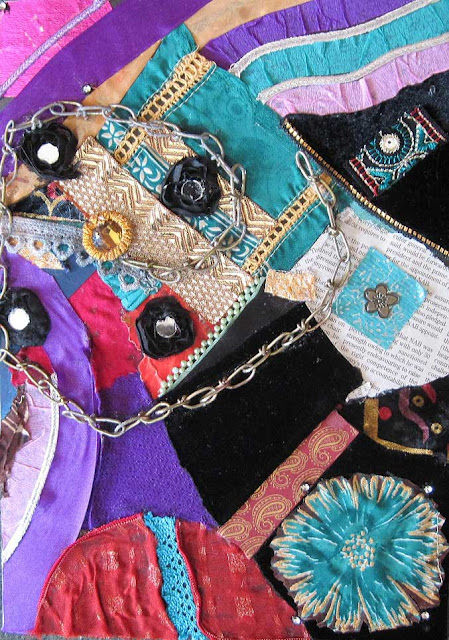 |
| Saba Malik, 26, Alliance Française: Positivity |
The winning collage, by Haider Abbas from Comsats University, uses the figure-ground relationship to show what at first glance appears to be a hand thrown dramatically into the air; but on looking closely one sees that the hand and the connecting arm are thrust between the legs of a half torso. Saweera Gul’s autumnal tree is another play on the viewer’s vision, mellower than the former, revealing a face composed of falling leaves and twigs beside the tree. Some of the entries show great maturity: Janita Fatima’s layered and clustered images which make up a face and a spiral, bombard the viewer with issues and question materialism; while Ikram Haider’s complex Everything or Nothing at All questions, among other things, standards of beauty, of skin colour, and of choice, using cut-outs from magazines and painting reproductions. Certain areas are delineated with the use of mirror frames held up by masculine arms. Anum Hamid’s three half-zippered, blanket stitched cloth pockets in magenta, blue and green are a play on colour, curiosity and the V sign; and Saadia Arhsad’s Mystic Maze uses traditional paper collage, combining images from cave paintings, photographs of terraced fields and a layered and shaded sky to make her mystic maze, which a shrouded figure contemplates.
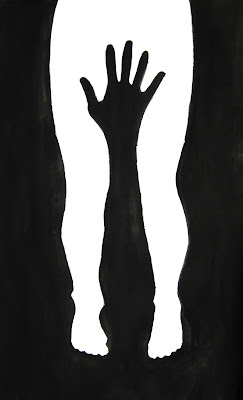 |
| Haider Abbas, 21, COMSATS University: Gestalt - First Prize |
 |
| Saweera Gull, 19, Post-Graduate College for Women: Aesthetics |
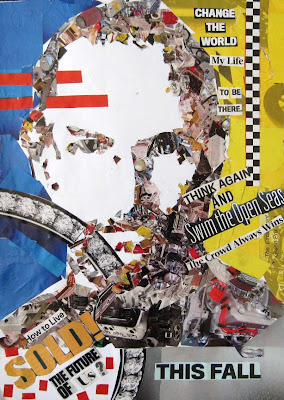 |
| Janita Fatima, 16, ICG: This Fall |
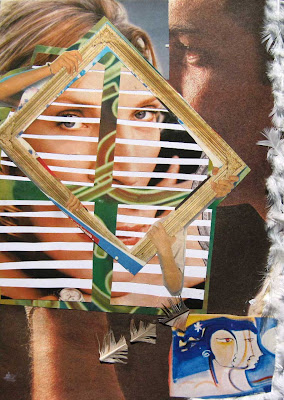 |
| Ikram Haider, 24, NUML: Todo o Nada (Everything or Nothing at All) |
 |
| Anum Hamid, 20, COMSATS University: Explore |
 |
| Saadia Arshad, 20, ICG: Mystic Maze |
Reviewing the project, Akerman considers that the best entries came from the Post Graduate College for Women Rawalpindi, Comsats University and Islamabad College for Girls. None of these can be considered educational institutions which provide a sophisticated education in the arts. Given a little help, the students’ natural curiosity led them to produce artworks revealing their understanding of theory and process received during the lectures. He compares the educational system to his experience in the Philippines, where he conducted a series of lectures and an art project on the botanist Carl Linnaeus. He feels that perhaps because of the difficulties that Pakistan is going through: physical and emotional insecurity, often a lack of basic amenities necessary to a stress free study environment, and a deficiency of intellectual material, young people are more profound than elsewhere and all the more inspired when shown a way to be original. Akerman also commends the teachers, some of whom were being exposed to unconventional teaching methods, for responding by accepting and using what they learned, and acknowledged them by giving them prizes during the award ceremony for the collage competition winners, organised at the German Embassy in December 2011.
 |
| "Gestalt Theory and Bauhaus Design" COMSATS University, 28 October 2011 |
Mariano Akerman’s lecture series, funded by and conducted at embassies, the Alliance Française and other educational institutions, have been a personal effort at bridging the gap between cultures. As the creator of each programme, he has approached embassies and institutions to initiate them, and has been instrumental in organising, designing, lecturing, as well as taking on the time consuming task of designing the brochures meant to introduce each set of lectures. Painstakingly researched and enriched with a library of visual images, the lecture series have so far included Discovering Belgian Art in 2008, Raisons d’Être, Art, Liberty and Modernity in 2009; Shape and Meaning, The German Contribution to the Visual Arts in 2010; and Gestalt, Theory and Design in the Age of New Objectivity in 2011. This last has seen an additional role of jury for the art competition.
_____
Ilona Yusuf spent her early childhood in England, where she was born. Later her family moved to Lahore, Pakistan, where she was educated. She is a published poet, and an editor for the Alhamra Literary review, a collection of writing by Pakistani and South Asian writers in English. “Picture This…” is her first book of poems. She also designs lamps and furniture, both of which she likes to call 'conversation pieces' as they often incorporate the use of her photographs. Currently she is working on using her photographs to make prints, after learning solar printmaking techniques. She divides her time between Islamabad, Pakistan, and Scottsdale, Arizona.
Blue Chip Magazine. Launched in 2004, Blue Chip has emerged as Pakistan’s premiere business magazine. Featuring the latest economic data as well as regular telecommunications, energy, capital markets and industry updates, Blue Chip has become an indispensable decision making tool within all levels of the private and public sectors. The magazine currently has a circulation of 6,000 copies a month primarily to Pakistan’s private sector including all levels of the financial sector from junior executives to senior management, all levels of industry including the telecommunications, energy, textiles and IT sectors. Blue Chip is also widely circulated in Pakistani government departments including the Ministry of Finance, the Board of Investment, the Securities & Exchange Commission, the Competition Commission, the State Bank of Pakistan, the Ministry of Health and the Planning Commission. It is circulated among all the embassies in bulk, particularly the Saudi, UAE, Chinese, US, UK and Argentine embassies which are then sent on to the various ministries abroad. Blue Chip is currently available on all PIA, Etihad and Cathay Pacific international business class flights originating from Pakistan.
Gestalt Program Resources
The Gestalt Program ; Programa Educativo Gestalt
Islamabad, German Embassy in Islamabad, Integrated Whole, Experimentation and Identity, Gestalt: Theory and Design in the New Objectivity Age, 25.10.2011
 |
| Bridging Cultures |
Sara Mahmood, Mariano Akerman: Bridging Cultures, 28.9.2011
Ishrat Hyatt, Gestalt Programme Launching Event, International The News, 22 October 2011, City News, p. 19 (S).
"The Ambassador of Switzerland ... held Reception Lecture of the Gestalt Educational Program held by Architect Mariano Akerman," Diplomatic Focus, Pakistan, Vol. II, Issue 8-9, October-November 2011, p. 70, photographs by Shabbir Hussain.
SwissPak Association
Almas Haider Naqvi, "Other is the Same Side of the Picture," Dataline Islamabad, 22 October 2011, p. 4
Maqbool Malik, "Tradition meets Modernisation," The Nation, Pakistan, 24 October 2011
 |
| Pakistan Observer, 3.11.11 |
Mariano Akerman, A Visual History of Gestalt Theory, 8.11.11
_____. Gestalt Program Pics and Musings, 30.10.11
Ilona Yusuf, "Enhancing Perception: The Gestalt Lectures and Collage Competition," Blue Chip Magazine, Issue 87, Volume 8, Islamabad, January-February 2012, pp. 16-19, ill.
Sara Mahmood, Mariano Akerman: Bridging Cultures, Blue Chip Magazine, Issue 87, Volume 8, Islamabad, January-February 2012, pp. 20-24, ill.




Comments received
1. Mi querido amigo este resumen de tu actuación concentra muy bien tu hacer y el valor que representa. Que tengas siempre la misma energía y capacidad de seguir por la misma exitosa senda [que hoy transitas] es lo que te deseo. Un beso fraternal. Gina desde el Centro
2. Herr Akerman, you should receive the first prize. The essay is well written and it has all what a good one needs to have. It is very interesting and covers your 5 years of stay in Pakistan, showing the fruits are ripe and giving the message you have worked on for so long. You get from me a medal. Deborah Cohen
3. Mariano: Leí el maravilloso artículo sobre tus cinco años en Pakistán. Siento asombro y orgullo por tu magnífica inserción en un mundo culturalmente diverso. Si "por los frutos los conoceréis", [entonces] ya puedo sentirme cumplida en esta vida. Tu capacidad intelectual, ética y de profunda llegada humana para con los asistentes a tus seminarios, te abren las puertas de cualquier lugar al que vayas. Importantes los antecedentes y el curriculum. Pero es el esfuerzo, el estudio profundo y permanente, la dedicación y la entrega con la que encaras todos tus trabajos los que construyen esos antecedentes. Eso se llama responsabilidad y amor por la tarea que realizás. Por eso, no dudo que continuarán los logros que cada vez serán aún más brillantes. NCL
